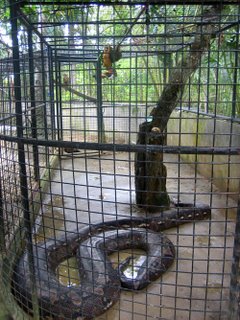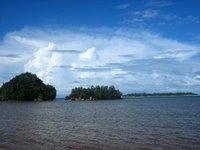Update #8







Hi all,
This last trip has by far had the highlights of my work. On the shooting list for the island of Bohol was the tarsier, bats, birds, frogs, flying lemurs and a few unexpected. We arrived by boat and were met by a team of biologists from the local university. The plan for the next few days was frog hunting and documentation in the wildlife reserve. Frogs are one of the most viable environmental indicators, meaning the first sign of an unhealthy environment is the lack of frogs. Being amphibians, their skin is in constant need of moisture and thus they need to live in the water systems. One of the first parts of an environment to show pollution is water systems and the skin of a frog is sensitive to these pollutants.
Frog hunting was not so much of a highlight. We were in a beautiful mountainous range where the clouds always seemed to be on fast forward. Every night, we would slosh up small streams searching leaves and embankments hoping to find some endangered species. We did find species; however, I could not tell you one of their names since the biologists only seemed to use Latin names. Late one night (actually about 8:00), I was resting my eyelids while leaning on a tree, when a guide in the team called out, “Tarsier!’ I had not expected to see one of these primates until later in the week and finding one in the wild is rare. I stared up at this shape climbing the vines in amazement! I had never seen a tarsier before and was looking at it trying to make out features. It seemed to have a long tail and rounded rear end. Everyone was running and calling “Where? Where?” The team arrived and we all fixed our lights on the poor animal frantically climbing. I was still amazed thinking how cool it was to see this reclusive thing. Then one of the other guides quietly said, “That’s not a tarsier, it’s a rat.” Almost immediately, I could see that is was a rat even though the second before I was able to see the alien features of the tarsier. That first guide then quietly followed the group after that as jokes came fast and furious.
After three days camping in the mountains, we took the van down to an area known for a species of bat called the wrinkle-lipped bat. The hike was near sunset and the views of golden green rice terraces backed by the mountains were amazing. I was trying not to stop every two minutes to shoot. We walked through canopied forests and fern covered paths down a quiet river bed. The river was suddenly swallowed by the mouth of a huge cave entrance. The cave entrance was well over 100 ft in diameter and it continued to grow as people walked closer and closer to it, giving greater perspective. We entered the cave and could just make out boulders on the cave bottom and large stalactites hanging from the ceiling. That is when the noise started. A whirring much like a wind storm became louder and louder. I could see the entrance beginning to fill with bats as the exited for the night. Then, we turned on the spotlights and we could see a literal tornado of bats circling the roof 150 ft up. I turned on the camera and light and began rolling on the action. Unfortunately, the light must have been the cue and soon what felt like rain started. Lightly at first, but soon it was coming down heavy: My first guano shower. We soon were left to shake off our clothes, clean our lenses and explore the stench-filled cave. Shining the light around, I found that we were standing next to a huge guano pile. It was literally 15’ high and about 30’ in diameter. This pile was representative of the local economy. Every week, that guano pile and many like it are harvested. The following week, the pile is refilled. That is a lot of crap!
Leaving the asphyxiating stench of the cave behind, we traveled into another reserve in hopes of finding the flying lemur. This primate is supposed to be the biggest and furriest glider in the world. I did not know what to expect from the lemur, I had forgotten what they looked like an imagined a monkey type face and body falling somewhat stone-like through the air. We entered a valley surrounded by a high ring of hills and cauliflower like dipterocarps. These trees are optimal for the lemur since they have long branchless trunks and a high canopy. The hills looked like thousands of toothpicks were jammed in them with a small umbrella on top. As we waited for the lemurs, we were entertained and annoyed by macaques as they begged for food and tried to steal my video tapes. Just as evening was setting one of the team spotted a group coming down and I ran over holding camera and tripod. The researcher is excitedly telling me to shoot them and I can’t see them at all. “Right there!” she said quite frustrated, but all I can see is a mass of trees and vines. It took awhile but I finally saw two and we were able to sufficiently light them for a shot. I tried to set up for a shot and then it flew/glided. How could I explain it? Since I missed the shot, I will have to explain. Have any of you ever seen Becky Queen of Carpets’ commercial? If you haven’t, she is the fat lady standing on a flying carpet with a background of St. Louis city behind her. Forget about the fat lady, I thought of the poor carpet she was floating on. It looked as if someone had thrown an ornate carpet out of the tree. But the carpet didn’t fall. It gracefully slid through the air on a slight decline and banked and curved back up to land lightly on a tree about 300’ away. Yes it is a glider, I know. The lemurs jumped a few more times and melted back into the forest leaving me with a few seconds of beautiful footage.
The rest of the trip was dedicated to tarsiers in the wild and captive. Tarsiers are supposed to be on of the oldest primates and they look a lot like ET with fur (pictures should be attached). The are small little creatures that fit smugly in the palm of a hand, which is precisely what used to happen at the local tourists stop. Once upon a time, tourists were able to pluck these creatures off the tree and have a picture with them. Finally, realizing the amount of stress this caused, the practice was stopped. Now, you are only able to stick a camera in their face, fire a flash in their nocturnal eyes and sing karaoke less than 50’ from their sensitive ears. After shooting a few ‘in the wild’ shots, we left for the mountains to search for them in their natural habitat. We drove over bumpy roads into the night and eventually stopped at a biological station and spring area. Tarsiers are active at night, so we met up with a 20 year tarsier veteran who showed would take us into the forests in hopes of seeing a few in action.
Tarsiers (in captivity) have a sloth like feel. They move sluggishly around branches and take their time. One thing I had forgotten is that these little creatures are insectivores and not herbivores. Meaning, the tarsiers have to be much faster to catch an insect than a leaf. Lito (the expert) generally knew where they would be and we walked into the forests no more than 15 minutes. On the way he was telling me about when National Geographic was here to shoot the tarsiers. They had spent a month shooting and apparently had much more equipment than my team did. In fact, from what I could glean, they had five spot lights with diffusers. I had two 2 million candlewatt flashlights. We arrived at the area he thought they would be and he told me to wait while they tried to call the tarsier using a very high pitched hissing sound. I eagerly set up my camera and figured out the settings I wanted excited I was on the same shoot as Nat Geo. I waited and waited amid the hissing sounds, crickets and night sounds that began to lull me to sleep. I kept telling myself, a good cinematographer wouldn’t fall asleep; I knew the boys of Nat Geo wouldn’t have hung over their camera with heavy eyes. After two hours of silence and the occasional flashlight in my eye, a small group was located and I geared up. The sloth-like beast I had seen in captivity was a far cry from the one I saw. It was jumping from tree to tree chasing moths while are beams chased the little monkey (not actually a monkey…I was told many times). It can jump over 10’ from branch to branch grabbing insects with its little hands and stuffing them greedily into its mouth. By the end of it all, we were exhausted, excited and a cement floor never sounded so good.
The experiences of Bohol have typified my journey throughout the Philippines. Tiring, but completely rewarding. Every bump, fall and cut has been paid off in triplicate by the beauty of the people and their country. I am always impressed by the kindness and friendliness of the Filipino people. They may be facing serious issues but are able to live life in an admirable way of quiet resolve and carefree attitudes. My work and journey here is nearing its end and I am sad that I won’t be able to jaunt around in vehicles which shouldn’t be allowed on the road or approach anyone with a question and get engaged in a half hour conversation.
I do have one last trip to the ocean for some surfing. There is a new typhoon forming up and we should be guaranteed some nice sized waves. The ocean has one last chance to leave me some sort of remembrance. Miss you all and see you soon.
b

1 Comments:
Hi, B:
I finally got to read your journal entry...and am glad I didn't have a full stomach, guano pile and all! We can't wait to see you! When do you get back? Today the boys were talking about you and wondering when you would get back from the "Fellopeens" (You think Jack would have a better handle on his birthplace.)
Post a Comment
<< Home